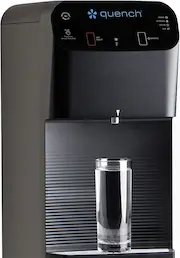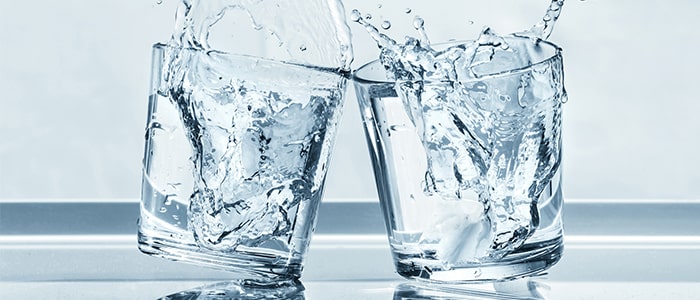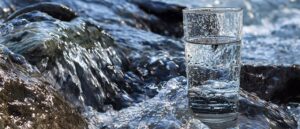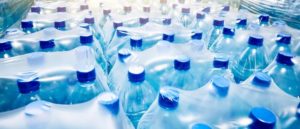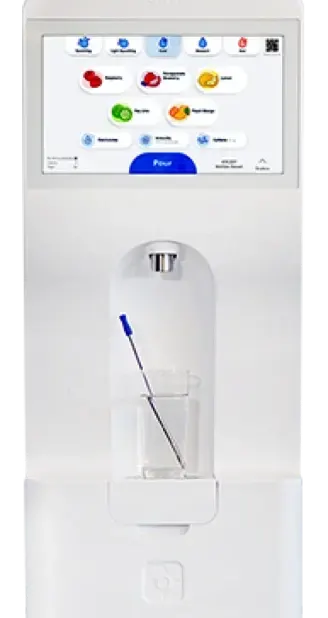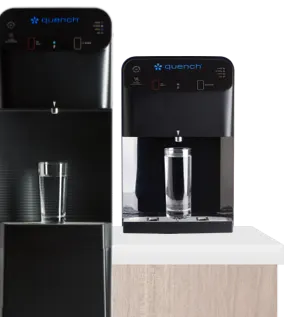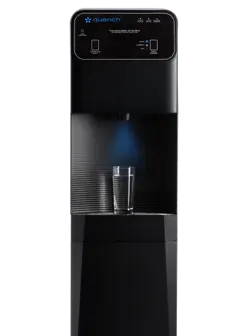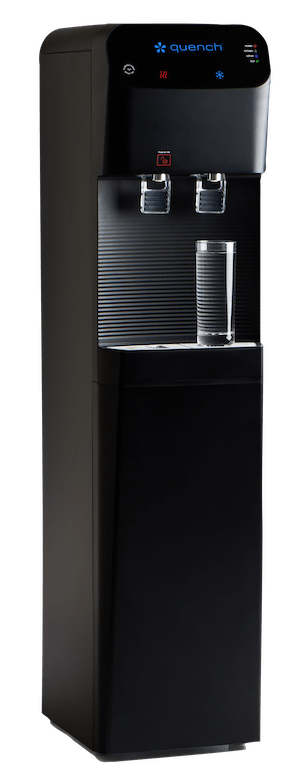Adequate water intake is essential to well-being, yet not all drinking water is created equal. Recognizing the differences between these alternatives may be key to fulfilling your unique water consumption needs.
We’re taking a closer look at the world of hydration options to determine the healthiest water to drink. Read on to learn more about the benefits and drawbacks of each type so you can make an informed choice about your drinking water habits moving forward.
Key Factors Influencing Drinking Water Taste and Quality
Staying hydrated is essential in regulating body temperature, supporting digestion, providing energy, and encouraging overall wellness. However, drinking water quality and taste can vary significantly even from one zip code to another.
The healthiness of your drinking water is determined by several key factors, including:
Water Source
Where your drinking water comes from will have a considerable impact on its final quality and flavor. For example, groundwater generally has a mineral-rich taste because of its passage through soil and rocks. This will likely differ from tap water, which is sourced from municipal supplies and may have added chemicals like chlorine for purification. Then there are alternatives such as sparkling water, offering a bubbly effervescence that adds a unique texture and flavor profile to the drinking experience.
Understanding where your drinking water comes from, recognizing the differences between sources, and considering your specific local water quality will enable more informed hydration choices in the long run.
Contaminants
The U.S. Environmental Protection Agency (EPA) has set standards for more than 90 contaminants that could be present in drinking water and threaten human health. Yet, these impurities continue to find their way into water supplies. According to the EPA, the most common harmful contaminants found in water supplies include:
- Microorganisms (e.g., E. coli, Giardia, and noroviruses)
- Inorganic chemicals (e.g., lead, arsenic, nitrates, and nitrites)
- Man-made chemicals (e.g., Per- and polyfluoroalkyl substances)
- Organic chemicals (e.g., atrazine, glyphosate, trichloroethylene, and tetrachloroethylene)
- Disinfection byproducts (e.g., chloroform)
Different impurities affect water quality and taste in distinct ways. Chemical pollutants can cause unpleasant flavors and odors, while high mineral content may alter taste and texture. Identifying which impurities are affecting your water supply and addressing them appropriately is critical to achieving safe drinking water.
Water Treatment Processes
Considering the harmful contaminants mentioned above, water treatment processes play an important role in boosting water quality and taste. Systems such as filtration, disinfection, and sedimentation remove impurities, chemicals, and microorganisms that can impact the healthiness of your drinking water. Some treatment methods, like reverse osmosis and activated carbon filtration, can also help enhance the flavor and odor of water by minimizing unwanted compounds.
Piping and Distribution Systems
Even if you don’t realize it, pipes and water distribution systems may impact your drinking water quality. This is often a result of corroded or deteriorated pipes, which can trickle contaminants into your water as it makes its way to the faucet. Moreover, old or outdated filtration or distribution systems can also contribute to mineral leaching and bacterial growth, altering water’s flavor.
Proper maintenance and regular inspections of your piping, distribution, and filtration systems are critical to ensure a clean, great-tasting cup of water every time.
Geography and Environmental Factors
Different geographical and environmental circumstances in your area will influence how drinking water tastes, looks, and smells. The composition of soil and rock formations in the region naturally affects the mineral content of water, which alters flavor and texture. On the other hand, proximity to industrial or agricultural activities might introduce pollutants into water sources, posing risks to your long-term health.
The Power of Healthy Water
Drinking healthy water is crucial for encouraging good hydration habits every day and promoting overall well-being. By choosing clean, quality water, you can boost hydration levels and enjoy a range of health benefits, including:
- Enhanced cognitive function: High-quality water supports optimal brain function, enhancing your focus, clarity, and overall cognitive performance throughout the day.
- Increased energy levels: Hydrating with clean water revitalizes the body, promoting higher energy levels and combating midday fatigue.
- Better physical performance: Adequate water intake enhances endurance, strength, and physical performance during activities and exercise.
- Improved mood: Staying hydrated with healthy water helps regulate your mood and emotional wellness, reducing feelings of stress and anxiety.
- Supported immune system: Quality water consumption boosts the immune system, aiding in the body’s defense against illnesses and infections.
- Better digestive health: Drinking purified water promotes proper digestion and nutrient absorption, which supports digestive health and regularity.

Decoding Drinking Water: Exploring Types and Trade-Offs for Optimal Health
Having trouble determining which drinking water option is best for your long-term health? We’re delving into popular drinking water alternatives and exploring their pros and cons so you can choose the alternative that suits your unique health and hydration needs.
1. Tap Water
Tap water is municipal water supplied through indoor plumbing systems for consumption in households and businesses alike. The 1974 Safe Drinking Water Act, aimed at safeguarding the quality of drinking water in the U.S., entrusted the EPA with regulatory control over public drinking water sources.
Because regular water undergoes treatment and rigorous testing before distribution, it generally meets stringent government guidelines. Plus, opting for a glass of plain water is inexpensive and readily accessible — not to mention it helps reduce plastic waste associated with bottled water consumption.
However, tap water affected by aging infrastructure, environmental factors, or inadequate treatment may contain trace contaminants like lead or chlorine. This can affect taste and odor, raising concerns about water quality, as seen in cases like Flint, Michigan.
2. Bottled Water
Unlike plain water from the tap, bottled water is regulated by the U.S. Food and Drug Administration (FDA). This includes flavored water and nutrient-added water beverages. Packaged drinking water undergoes treatments for cleanliness and it’s often a go-to choice for convenience and portability. While bottled water offers easy access and a perceived sense of purity and safety, the reality may not always match expectations.
Despite stringent filtration processes:
- Lapses in treatment and handling can render it microbiologically unsafe.
- Plastic bottles themselves may contain harmful chemicals that can leach into the water over time.
- Exposure to sunlight may trigger harmful chemical reactions in plastic bottles.
Additionally, the manufacturing, packaging, and transportation of bottled water substantially contribute to environmental pollution and plastic waste. To put it into perspective, a report from the United Nations University Institute for Water, Environment, and Health reveals that over one million bottles of water are sold worldwide every minute, with about 85% of them becoming waste. Moreover, bottled water typically comes with a higher price tag compared to regular water, potentially causing financial strain over time.
3. Distilled Water
Distilled water is created through the process of distillation, where water is boiled, vaporized, and then condensed back into liquid form. This is an effective approach to eliminate contaminants and bacteria, which may be beneficial for individuals who want purified water or those with certain medical conditions.
However, its purity also means it’s devoid of the additives and healthy minerals found in tap water, such as calcium, magnesium, fluoride, and chlorine. This can potentially lead to mineral deficiencies if consumed exclusively. Plus, distilled water’s bland taste is less likely to encourage adequate daily hydration. That’s why it’s less commonly consumed for drinking purposes and more frequently utilized in appliances or medical procedures.
4. Sparkling Water
Sparkling water, often referred to as carbonated water or soda water, is infused with carbon dioxide gas to create its signature bubbly effervescence. Renowned for its refreshing taste and versatility, sparkling water offers minimal calories, aids hydration, and boasts various flavors. And as a healthier alternative to sugary sodas, it’s ideal for curbing mid-day cravings.
However, excessive consumption can erode tooth enamel due to acidity and can even cause bloating for some. What’s more, if served in single-use plastic bottles or aluminum cans — rather than reusable containers or point-of-use coolers — it contributes to environmental degradation.
5. Mineral Water
Mineral water, whether sourced naturally from springs or created, contains essential minerals like calcium, magnesium, and potassium. These beneficial minerals not only enhance taste, but also offer potential health benefits like improved bone strength and digestion. Some options are even naturally carbonated, providing another refreshing alternative to sugary sodas.
Despite its health advantages and preferred taste, the cost of mineral water remains a concern — especially when healthy minerals can be obtained from a balanced diet. Plus, excessive consumption of sodium-rich mineral water may not suit restricted diets, and single-use packaging ultimately contributes to environmental issues.
6. Alkaline Water
Alkaline water, with a higher pH than regular tap water, is often produced through processes like ionization, mineralization, or using alkaline water filters. Consequently, it supposedly offers health benefits like neutralizing body acid and improving hydration. However, experts caution about the lack of scientific evidence supporting these claims.
Not only does this type of drinking water come at a higher cost, but excessive consumption may lower stomach acidity, hindering bacteria elimination and causing metabolic alkalosis. This can quickly lead to unpleasant health issues like nausea and vomiting.
7. Filtered Water
Filtered water undergoes a purification process to minimize impurities, chemicals, and contaminants, typically using methods like carbon filtration, reverse osmosis, or UV treatment. This leads to benefits including improved taste, odor, and safety, while a point-of-use option can simultaneously reduce your environmental impact.
However, some contaminants may still pass through specific filters despite meeting safety standards. And installing a filtration system entails an initial investment and ongoing maintenance for the best performance.
So, What’s the Healthiest Water to Drink?
Determining the healthiest water to drink isn’t one-size-fits-all; it changes based on lifestyles, hydration needs, and even dietary restrictions. Regardless of your choice, remember that filtration is key. Methods like carbon filtration and reverse osmosis help minimize contaminants and improve water’s taste, supporting your overall wellness. However, relying solely on one filtration system may not be enough. Instead, a comprehensive system with a layered filtration approach is recommended to ensure the cleanest, best-tasting water for staying hydrated and healthy.
Quench bottleless water coolers for the workplace feature quenchWATER+, which includes a 5-filter setup to ensure top-notch water quality. Quench Q-Series machines take advantage of a sediment filter, pre-carbon filter, reverse osmosis filtration, mineral + filter, and polishing filter to deliver crisp, alkaline hydration on demand. Plus, cutting-edge sanitization technology and ergonomic designs make these bottleless coolers the ultimate choice for healthy, great-tasting water in any setting.
Accessing Endless, Healthy Water at Your Fingertips
Choosing healthy drinking water not only promotes greater hydration, but also contributes to your long-term wellness. Quench bottleless water coolers offer an efficient and cost-effective way to access clean and refreshing filtered water for homes and workplaces alike. That includes a range of filtered sparkling water and flavored water options as well. A bottleless cooler that provides healthy, great-tasting water on demand makes it easier and more convenient to stay hydrated than ever before.
Try our product finder to get matched with the machine that’s right for your needs, or get a free estimate to get started.
